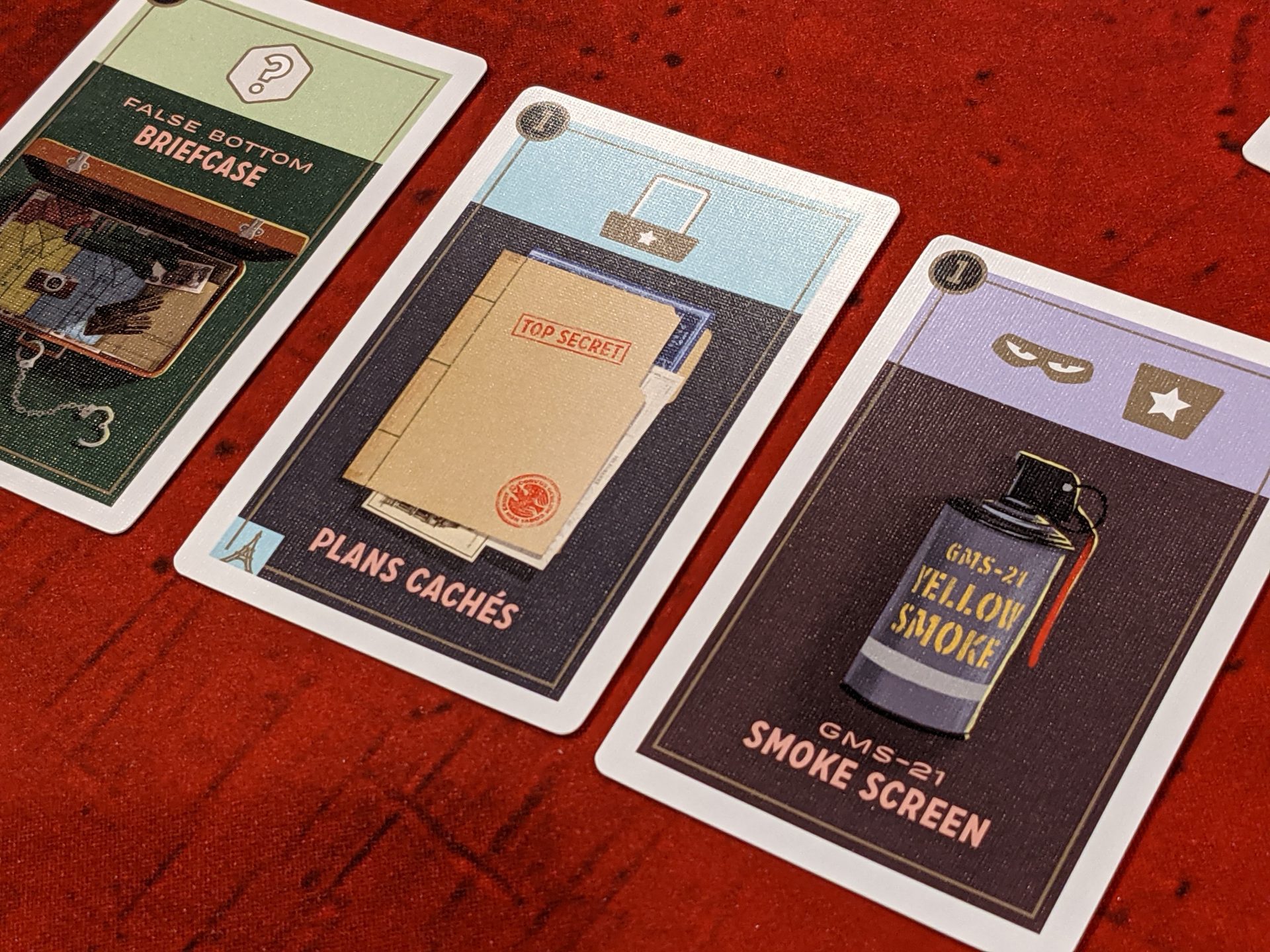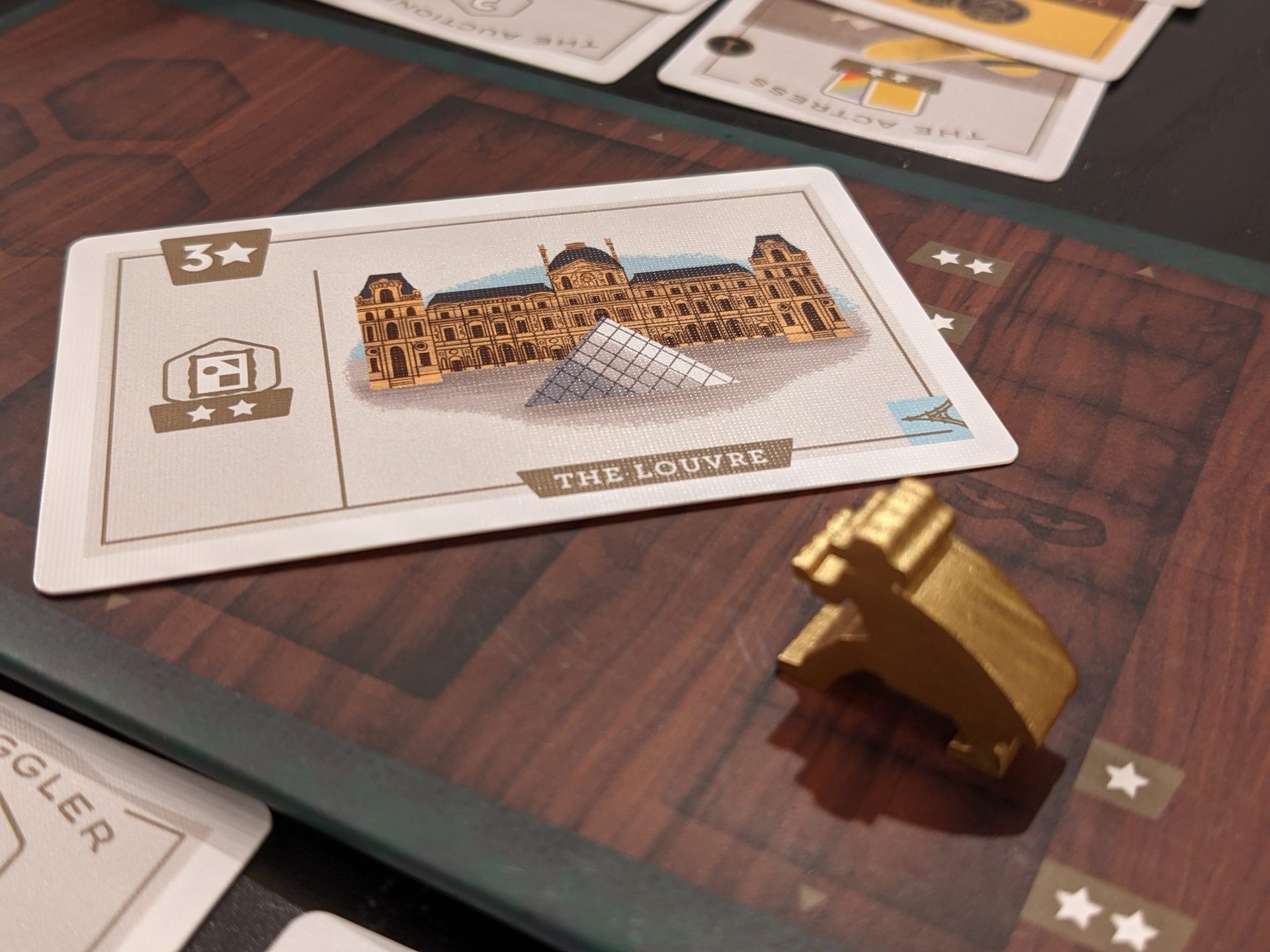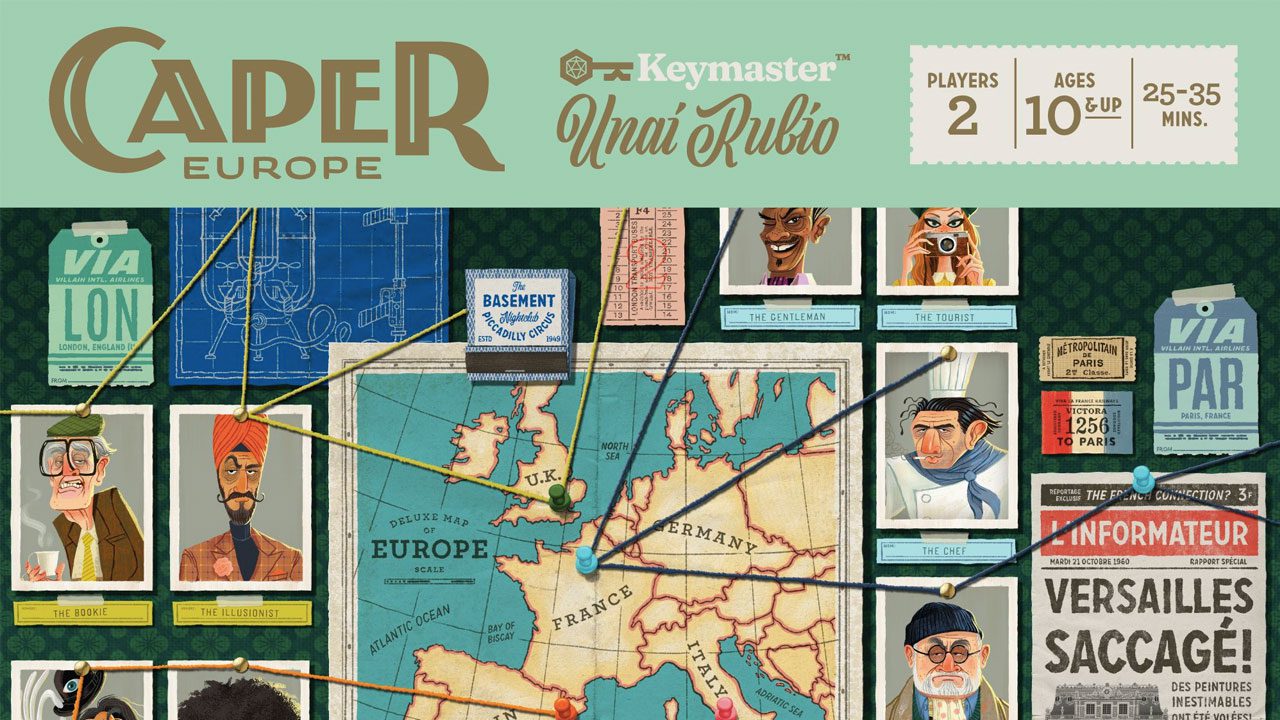Disclosure: Meeple Mountain received a free copy of this product in exchange for an honest, unbiased review. This review is not intended to be an endorsement.
For a couple of years now, one of the people in my gaming groups has been swearing that Caper, a 2018 release from Keymaster Games, is a fantastic, but hard-to-find, two-player gateway game that features quick turns, incredible production values and light-hearted “strategerie” and take-that elements. I like to have a few games like this in my collection because those will always work for my wife–a solid gamer who, thanks to her work schedule, usually likes to fit in a quick game after the kids go to bed and before she logs back on to her laptop–so I’ve been trying to find Caper for a while now.
Sadly, Caper is out of print. However, Keymaster has launched a Kickstarter campaign for an updated, more refined Caper experience, Caper: Europe. Caper: Europe is also designed by Unai Rubio but tweaks minor parts of the experience to come up with a game that supposedly keeps the best parts of the original game while making Caper: Europe a more accessible version.
The folks at Keymaster–who are best known for the PARKS series of games, which include the base game, Nightfall expansion, and the PARKS Memories matching games–have clearly nailed the street cred when it comes to superb artwork and accessibility for a wide variety of gamers.
Have they succeeded, then, in giving players a world-class experience with Caper: Europe? Keep reading to learn more.

The Blueprints?
Caper: Europe is a two-player drafting game; over the course of six quick rounds, players compete to score the most points by using a mix of tableau building, area control and item set collection to win. You’ll have to build the best crew with the most appropriate tools to snag the loot and the victory!
The layout of the game features three location cards placed on the board; these will serve as the targets of each player’s potential robberies for the current game. Four items, known as Stolen Goods, are added to each of these locations; these 12 items are divided evenly (gems, paintings and antiques) but distributed randomly to the three locations. An area control marker known as a “thiefle” is added to measure control of each location; at the end of the game, whichever player has that location’s thiefle closest to their side of the board will win the end-game points from that location.
Also, a round tracker separates the two main decks of cards which dictate play: a thieves deck and a gear deck.
At the start of each round of Caper: Europe, players draw a certain number of cards from one of these two decks (rounds 1, 3 and 5 for thieves, rounds 2, 4 and 6 for gear). Each player–or “Mastermind”–can play just one card into their tableau on their turn, at one of the three locations, while potentially receiving an immediate, one-time benefit. After playing a card, players pass their entire remaining hand to the opposing player, so cards are never really secret for long!
When each player is holding one last card at the end of the round, that card is discarded from the game. At the end of the sixth round, you’ll total scores from controlled locations, sets of stolen goods (sets of unique goods score more points), and any points on the cards from your thief and gear combinations.
The game’s location, gear and thieves decks vary; the box includes a general set of each type, and each deck is then mixed with one of four specific city decks (Paris, Rome, London and Barcelona, which also scale the difficulty of the game from easy to more challenging). This gives each game a bit more variability, but each core deck is about 75% of the total, with the city-specific cards making up about 25% of each deck.
(The preview copy of Caper: Europe only included the game’s base and Paris components, not the additional three cities which will be included in the full game. Also, we used the draft version of the rules, meaning that the player aids were not included in the preview copy provided to Meeple Mountain.)

Is the Third Time a Charm?
I can’t speak to the main changes of how Caper: Europe compares to Caper, itself a build on the game It’s Mine, Rubio’s original version of this game’s design from 2015. As it is, then, it’s fair to say that Caper: Europe is essentially version 3.0 of It’s Mine, with each version being a slightly upgraded experience.
It does seem like the rules have been refined to balance gameplay, the artwork features a very diverse, inclusive cast of characters (a change from the first two versions of the game), and player order and other rules tweaks have clearly been taken into account based on feedback from the Caper community.
This leads to an above-average experience, one that is firmly set at the kinds of gateway experiences in which Keymaster Games thrives. At 20 minutes per play, Caper: Europe is a game that anyone can get to the table, and one which gamers of all experience levels will enjoy. The decisions from turn to turn are interesting, but never severe or mind-blowing; the fifth round of the game, when you draw two thieves to play one and discard the other, might be the shortest “round” of any game in modern gaming history. Even the most analysis paralysis-prone players will finish a game of Caper: Europe in 30 minutes; my wife and I played our first three games of Caper: Europe back-to-back-to-back in just over an hour.
There’s plenty to enjoy here. Let’s start with the metal coins; the weight of these things is incredible, and it makes throwing them into the general pool after spending on new gear each round lots of fun. There is decent variety in the core card selection, but even when those cards feel familiar, that allows for players to identify the ones they want to build around in current and future games quite easily. The artwork is stunning, the stolen goods components have a nice chunky feel to them, and the finish on these cards make it exciting to deal each round. There is nearly zero downtime between turns; occasionally, you’ll stare at cards to figure out the best gear to play on a thief at a specific location, usually on the first turn of each gear phase because you’ve got six potentially great choices to consider, but outside of this the turns are really smooth.
After our first few plays—and despite the super-quick play time—it was hard to envision Caper: Europe replacing our favorite two-player games. We love 7 Wonders: Duel, Unearth, Agricola: All Creatures Big and Small …heck, my wife and I still play San Juan a few times a year. I think that’s because those other games have combinations that we are still discovering; Caper: Europe’s system lends itself to playing cards at certain locations or with certain thieves that are just plain better for endgame scoring chances. (Let’s just say that The Gentleman is a thief you will employ regularly.)

“The Italian Job”…in 20 Minutes or Less
I’m always hunting for games that allow me to play a quick game with my wife which is easy on the mind, so that when I have to break up a toddler fight or start dinner I can drop in or drop out with minimal stress.
Caper: Europe can certainly fill that void. “Pleasant” was the word my wife used after our first night with the game, and I would add “elevated.” For gamers who need something quick to start a two-player game night, this is an elevated experience which will leave players appreciative of the incredible attention to the production detail; for those looking for the “be all, end all” gaming experience of this lifetime, Caper: Europe is not that game.
Caper: Europe leans on the theme of rounding up a crew to rob a bank and elevates this pipe dream while distilling it into a 20-minute romp of general amusement. Some of the card archetypes are funny! The serial numbers for some of the gear cards are cute! The idea of robbing Moulin Rouge is interesting! As a casual game experience to enjoy with a friend or partner over a glass of wine, Caper: Europe is lovely.
Over time, though, I think this will be more of a dalliance than a long-term relationship, especially at the entry price of $39 plus shipping. Caper: Europe shines, but it would overstay its welcome after the tenth play, even with a wider variety of the city cards. Whether that means you should invest is purely in the eye of the beholder; the Caper: Europe Kickstarter is live right now!












Thanks for the excellent review! Based on this, I will pass on Caper: Europe. 🙂